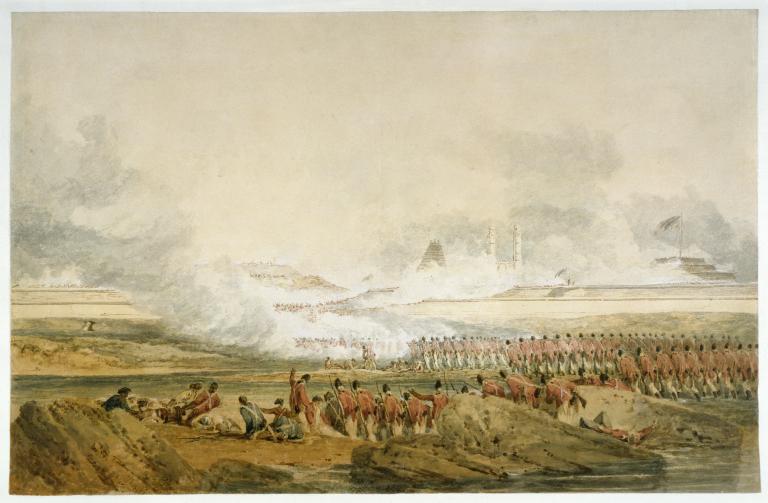Joseph Mallord William Turner The Siege of Seringapatam c.1800
Joseph Mallord William Turner,
The Siege of Seringapatam
c.1800
Joseph Mallord William Turner 1775–1851
The Siege of Seringapatam c.1800
T04160
Pencil, watercolour and gouache with scraping–out on white wove paper, 421 x 647 mm
Purchased 1986
Provenance:
...
Colnaghi, London
Bought 1948 by Ray Livingston Murphy, New York (died 1953)
Murphy estate, Christie’s, London, 19 November 1985 (26, as by William Daniell), withdrawn
Sold Christie’s, London, 18 March 1986 (109), acquired on behalf of Tate
...
Colnaghi, London
Bought 1948 by Ray Livingston Murphy, New York (died 1953)
Murphy estate, Christie’s, London, 19 November 1985 (26, as by William Daniell), withdrawn
Sold Christie’s, London, 18 March 1986 (109), acquired on behalf of Tate
Exhibition history
1988
Young Turner: Early Work to 1800: Watercolours and Drawings from the Turner Bequest 1787–1800, Tate Gallery, London, January–March 1988 (47, reproduced).
References
1987
Evelyn Joll, Review of ‘Two Watercolour Exhibitions in the Clore Gallery’, Turner Studies vol 7 no 2, Winter 1987, p. 54; p. 64.
1988
The Tate Gallery 1984–86: Illustrated Catalogue of Acquisitions: Including Supplement to Catalogue of Acquisitions 1982–84, London 1988, pp.82–3, reproduced.
1987
Andrew Wilton, Turner in his Time, London 1987, pl.59.
1988
Andrew Wilton and David Blayney Brown, ‘Picture Notes: The Siege of Seringapatam’, Turner Studies, vol.8, no.1, Summer 1988, p.59.
1989
Anne Lyles, Young Turner: Early Work to 1800: Watercolours and Drawings from the Turner Bequest 1787–1800, exhibition catalogue, Tate Gallery, London 1989, reproduced in colour p.20, pp.41–2 no.47, reproduced.
2001
Andrew Wilton, Turner, Girtin and Bonington: A New York Private Collection: Paintings, Watercolours and Drawings, New York 2001, p.40, fig.5.
Andrew Wilton, ‘More News of Turner’s Seringapatam Cycle’, Turner Society News, no.119, p.15.
The forces of General Baird took Seringapatam from Tipu Sultan in May 1799, bringing to an end the Mysore Wars. A large oil painting of the siege was produced by Robert Ker Porter (1777–1842), Turner’s colleague in the Royal Academy Schools; it is now in Tipu’s Summer Palace at Seringapatam. Porter made a series of engravings after it, which were widely circulated. Many other artists also recorded this important battle.
A group of three watercolours, formerly attributed to William Daniell (1769–1837) but in fact by Turner, apparently based on drawings by one or more eye–witnesses, show the Residence of the Mysore Rajah within the fort of Seringapatam, during the last three years of his confinement, Hoollay Deedy, or new Sally–port in the inner Rampart of Seringapatam, where Tippoo Sultaun was killed, on the 4th May 1799, and the present work, a general view of the siege with the British forces crossing the river Cauvery (all with Colnaghi, 1948; bought by Ray Livingston Murphy, offered for sale at Christie’s, London, 19 November 1985 as lots 24, 25 and 26, as by Daniell, but withdrawn).
A coloured study adumbrating the whole composition of this last of these subjects was in Turner’s studio, and is now in a private collection.1 A study for a further subject in the series is Tate D17190 (Turner Bequest CXCVI Z), which seems to have been based on an anonymous drawing. Hoolley Deedy was based on a drawing made on the spot by Thomas Sydenham (1780–1816), now in the India Office collection at the British Library, London.2 The watercolour of the siege itself follows a drawing by Captain Alexander Allan, present at the battle, which Turner might have seen either in the original or in the form of an engraving. Visible amid the smoke of battle are the fortifications of the city, the pyramidal gopura or entrance tower of the Hindu temple, and the minarets of the Mosque.
This is in many respects a perfunctory performance, but it is an extremely ambitious drawing, the first surviving battle scene in Turner’s oeuvre; he showed an oil painting of the Battle of the Nile, at 10 o'clock when the L'Orient Blew Up, from the Station of the Gun Boats between the Battery and Castle of Aboukir at the Royal Academy in 1799,3 but it has never been traced. Although there is no evidence for a commission it is likely that he was asked to make the series of Seringapatam subjects by someone like Allan or Sydenham; it possible that the commission came from Thomas and William Daniell, famous for their Indian views, whom Turner knew.
Technical notes:
The sheet is somewhat faded.
Verso:
Blank
Andrew Wilton
May 2013
Revised by Matthew Imms
April 2015
How to cite
Andrew Wilton, ‘The Siege of Seringapatam c.1800 by Joseph Mallord William Turner’, catalogue entry, May 2013, revised by Matthew Imms, April 2015, in David Blayney Brown (ed.), J.M.W. Turner: Sketchbooks, Drawings and Watercolours, Tate Research Publication, April 2016, https://www

